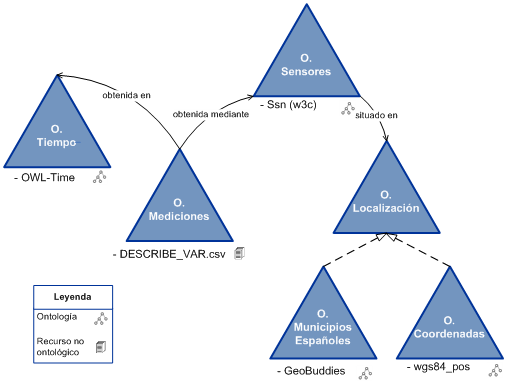Models
The aim of the AEMET ontology network is to represent knowledge related to measurements made by the network
of meteorological stations of the Spanish Meteorological Agency . Each of these measurements represents the state of
the atmosphere (humidity, pressure, temperature, wind, etc.) in a particular place and time and is conducted through
the sensor equipped with each weather station.
AEMET ontology network follows a modular structure consisting of a central ontology (aemet.owl file) that links
together a set of ontologies that describe different sub domains involved in the modeling of the meteorological measurements.
These sub domains are: Measurements (weather), Sensors, Time and Location.
Following the approach proposed by the NeOn methodology it has been decided to develop the ontology network by
reusing as many sources of knowledge (both ontological and non-ontological resources) as possible instead of building
the network completely from scratch. In this way, we have selected the following resources to develop each of the sub domains
listed:
• The modeling of the network of sensors and weather stations was based on the reuse and extension of the
Semantic Sensor Network (Ssn) ontology developed
by the W3C Semantic Sensor Network Incubator Group.
• To model the sub domain related to meteorological observations, the NOR2O tool was used to transform Non ontological
resources provided by the Meteorological Agency to ontological resources. After obtaining the ontological resources it has
been undertaken a restructuring process of the resources and their integration within the ontology network.
• To represent temporal information, we have reused the OWL-Time ontologydeveloped in the context of the World
Wide Web Consortium (W3C). This ontology provides a vocabulary to express temporal information as time instants or intervals
and their topological relationships.
• Regarding the location information, we have reused the wgs84_pos vocabulary developed by the
W3C Semantic Web Interest Group
with the aim of supporting the representation of geometric positioning. In addition, it has been reused part of the
Geobuddies ontology network to represent knowledge about the Spanish administrative division.
Finally, it is worth mentioning that the development of the AEMET ontology is an evolutionary process that is under development. Figure 1 shows the relation between the domain ontologies that formed
the AEMET ontology network. In the following link you can find the latest prototype at:

Figure 1. Conceptual Graph of the AEMET ontology network.
In this link you can find the current version of the AEMET ontology network.
|


